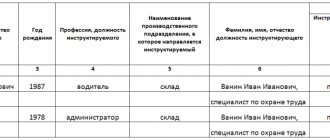Who monitors staff working hours?
Every fairly large organization has an employee who is responsible for recording staff working hours. Usually this:
- HR specialist;
- security service representative;
- head of one or another structural unit;
- secretary.
In a special journal, this person notes the time his colleagues arrived at work, as well as the time they left home.
All lateness, absenteeism, absences from the workplace for professional needs and personal matters, and overtime are also entered into the accounting document.
This practice allows the employer to know exactly how much time one or another of his subordinates spent at his workplace, whether he worked the required hours, how accurately he complies with labor discipline and the work and rest regime in force at the enterprise.
https://youtu.be/LrJoigHaoEA
What is considered late
Every large organization has a person who is responsible for and daily records the time workers arrive at work and the time they leave home.
The absence of an employee from the workplace at the time established for work for a period of 1 minute to 4 hours is considered, regardless of when it was recorded - at the beginning, in the middle or at the end of the working day. Absence of more than 4 hours is considered absenteeism.
In order for employees to maintain discipline, their late arrivals to work cannot be ignored. Each such case should be recorded, discussed and resolved. If the offense was committed without a good reason, sanctions in the form can be applied to the worker. Only in this way will workers understand the seriousness of the situation.
Drawing up an act of being late for work is the first step in documenting the offense.
Situations in which it is impossible to do without drawing up a report of being late for work
Each company has its own operating hours. In some places the work schedule is quite free - the main thing is to work the required 8 hours a day or 40 hours a week, and in some places being late even one minute is a serious administrative offense (more often in large industrial enterprises with a continuous production cycle).
Usually, if an employee is late for work without serious reasons and good reasons, he strives to somehow come to an agreement with the employer. And in most cases this can be done. However, such a peaceful way of resolving the situation will not work if the employee is late for more than the first time, or if he behaves provocatively and inappropriately.
In such cases, the employer's representative will most likely draw up a report of lateness. And this will be a serious document, on the basis of which the violator may be subject to disciplinary action in the future (up to and including dismissal if he is regularly late).
Compilation rules
The act is a document on the basis of which the violator may be subject to disciplinary action.
It is drawn up by the employer in one copy and in any form. In this case, two witnesses must be present who, with their signatures, certify the correctness of the information specified in it. As an example, you can use the sample act of being late for work, posted in our article.
In the header you need to indicate:
- Name of the organization;
- Title of the document;
- date of preparation, document number;
The main part states:
- position and full name of the compiler;
- positions and names of persons present during the preparation of the document;
- position and full name of the labor discipline violator;
- the time the employee arrives at the workplace. Here you must indicate exactly how many hours and minutes he was late.
The person has two days to provide the employer with a written explanation of his misconduct. If it was provided, this must be indicated in the document, as well as the opposite situation, when the employee cannot give an explanation.
If necessary, it can be supplemented with any other information, depending on the specific circumstances. The finished document is signed by all persons present. The offending employee also signs his signature as a sign of familiarization with the paper. If for some reason he does not want to do this, he needs to make a note about this in the act and draw up a second act of refusal to familiarize himself.
Being late for work is one of the most common violations committed by employees. Some organizations turn a blind eye to minor delays as long as the work gets done. In others, being late is fraught with reprimands from superiors and various punishments. How serious is this offense, what threat can it pose to the employee: let’s consider these issues from the point of view of labor legislation.
Let's start with the fact that in the Labor Code there is no concept of “lateness” at all. The law considers the situation as a whole and operates with the concepts of “work and rest schedule”, “internal labor regulations”, “labor discipline”. Indeed, why somehow highlight being late for work, because it is essentially no different from leaving early, and not only at the end of the working day, but also, for example, during a lunch break?
In addition, the very concept of “work” is quite vague, because you can pass through the checkpoint in a timely manner, and then be in the smoking room, instead of performing your job duties by the sweat of your brow.
So, according to the Labor Code, the absence of an employee without a good reason from the workplace and at the time established by the internal labor regulations, legal orders and instructions of the manager, the employment contract - in any case, is a violation of labor discipline: whether it is lateness, premature departure from work or an unauthorized “smoke break.” Punishments for violations are quite specific and there are only three of them: reprimand, reprimand, dismissal.
It should be immediately clear that the imposition of such disciplinary sanctions as reprimands and reprimands is entirely the prerogative of the head of the organization, and he has the right to apply them for any violations of labor discipline. The only thing that somewhat limits it is the last paragraph of Article 192 of the Labor Code, which reads:
“When imposing a disciplinary sanction, the severity of the offense committed and the circumstances under which it was committed must be taken into account.”
Dismissal is an extreme measure, and therefore all the reasons for such punishment are clearly outlined in Article 81. In the context that interests us, let us note paragraphs 5 and 6a of this article: an employee can be dismissed if he repeatedly fails to fulfill his job duties without good reason (if he already has an outstanding balance). disciplinary action) or absence from work without good reason for more than four hours in a row. Let us clarify: any violation of labor discipline, even a minor one, is a failure to fulfill labor duties, and the term “repeated” applies not only to, for example, the tenth violation, but also to the second.
Let's sum up a short summary:
- If an employee is more than 4 hours late and cannot document that this happened for a good reason, then the employer has the right to fire him for absenteeism. Even if the employee is an athlete, Komsomol member and beauty and has never allowed anything like this before.
- If an employee is late for up to 4 hours and this happened for the first time, then he faces punishment in the form of a reprimand or reprimand. For being five minutes late, issuing a reprimand is unlikely to be appropriate, but options are also possible here (for example, we could be talking about working on an assembly line at a car assembly plant, where every minute of downtime leads to thousands of losses).
- If an employee is late within a year after he has already been punished with a reprimand or reprimand (for any violation), and the previous penalty was not lifted by a special order, then he falls under the clause on repeated failure to fulfill labor duties and theoretically can be completely legally dismissed .
- The listed punishments, generally speaking, are possible, but not obligatory, since, we repeat, the imposition of one or another penalty is still a right, and not an obligation, of a manager. For a good leader, it is much more important to instill discipline in already proven and perhaps not the worst employees than to “wave a saber”, increasing staff turnover and destroying an established team.
- Taking advantage of the emerging opportunity to “execute or pardon” when employees are late, some managers invent various “educational” measures: fines, detentions, etc. It is difficult to say anything definite about this: each specific case must be considered. On the one hand, any other punishments other than those listed in the labor code are prohibited and in some cases can be easily challenged in court. But on the other hand, a smart manager can do everything completely legally: for example, fines may turn out to be a regular reduction in bonuses by one amount or another, work hours may be justified by an employment contract with a clause on long working hours, etc. The most important thing is to understand the essence: an employee who violates labor discipline puts himself in a disadvantageous and dependent position.
Registration of collection
Be that as it may, the most logical and, as a result, the most common punishment for being late is a reprimand. Let's look at the subtleties of this procedure, as specified by law.
Firstly
. the fact of being late must be documented. The document can be a report from the immediate supervisor of the late employee, timekeeper or other specially appointed person exercising control. The form of such a report is quite arbitrary, the main thing is that it reflects the fact: such and such an employee was absent from the workplace for such and such a time, from start to finish.
Secondly
. Before imposing a penalty, the employee must be required to provide written explanations about the reasons for the violation.
Even if this time everything goes well without collection, the report and explanatory notes must be submitted and properly executed: dates, signatures. If the employee turns out to be a habitual violator, then in the future these documents may serve as grounds for the application of more severe penalties.
If a late worker refuses to write an explanation, then it is necessary to draw up a corresponding act signed by the manager and two witnesses.
Third
. If the manager has decided to impose a penalty, then he must formalize it by order of the organization.
In general, a penalty must be imposed within a month after the commission of the offense (in this case, being late); after this period, it will no longer be possible to issue a reprimand or reprimand. If the employee goes on vacation or sick leave, the period can be increased to 6 months.
The order must be delivered to the employee against signature within three days after issuance. If the employee refuses to sign the order, then it is also necessary to draw up a report about this.
A reprimand or reprimand is considered valid for one year from the date of issuance of the order, after which it is automatically considered cancelled. The manager can remove the penalty ahead of schedule, for which he must issue a corresponding new order.
No one is immune from occasional delays to work: everyone can get stuck in a traffic jam or wake up in the morning to find a flood in their own bathroom. But systematic lateness can result in the most unpleasant consequences for an employee. Only in order to organize these consequences for a negligent employee, management will have to try: you can’t just punish anyone. Registration of a disciplinary sanction begins with recording the fact of a violation. In our case, this will be an act of being late for work.
Who forms the act of lateness?
The report of lateness is usually written by the same employee who keeps track of the employees’ working hours.
When drawing up the act, it is imperative that at least one, or preferably two, witnesses be present, who will certify with their autographs that all the information included in the act is true.
The employee who is late must also sign the document. If for some reason he does not want to do this, this must be noted in the act.
Features and design rules
There is no unified sample act for an employee being late for work, so it can be drawn up in free form or according to a template developed by the organization. If such a document is being drawn up for the first time, the following structure can be proposed:
- date and time of compilation;
- Full name of the official who executed the act;
- Full names and positions of persons present during the formation of the document;
- Full name and position of the latecomer;
- the time at which the offender arrived at the workplace. Here you must indicate exactly how late the employee was.
You should beware of the wording “without good reason”, since according to Part 1 of Art. 193 of the Labor Code of the Russian Federation, the employee has two days to provide a written explanation of his misconduct, which the employer must still request from him. Thus, the act records only the time of absence and nothing more.
Here is a sample report of being late for work. Let us remind you that it is not necessary to compose it in exactly this form.
Sample report of being late for work
ppt.ru
Features of the act, general information
If you are faced with the need to draw up an act of being late for work, but you do not know exactly how to do this, read our tips and pay attention to the example document.
First, let's give general information that applies to any papers of this kind:
- Today there is no unified model of the act. This means that you can write it in free form or, if the organization has a document template, according to its type.
- Any act must have a certain structure, which includes a “header” - the beginning of the document, the main part and the conclusion.
- The act must necessarily include the signatures of the drafters, but it is not necessary to put a stamp on it. This is due to the fact that recently the mandatory requirement to use stamps for document approval has been abolished, so the act must be stamped only when such a rule is in the organization’s regulatory documents.
In addition, keep in mind that the act can be drawn up on a regular blank sheet of any convenient format (preferably A4) or on company letterhead. It is allowed to print the act on a computer (with subsequent printing) or write it by hand (without blots, errors or corrections) - all this does not matter in determining the legality of the document.
The act is made in two copies , which must be identical in content and equal in law. One copy of the document remains with the employer, the second is given to the employee who is late for work.
Certificate of absence of an employee from the workplace - sample
According to labor legislation, being late for work is a violation of labor discipline. If an employee repeatedly commits such a violation, the employer has the right to dismiss him on his own initiative.
| What documents need to be completed | How to draw up a document |
| Act of being late | The document is drawn up in the presence of two witnesses and contains information about the time of reporting to work and the duration of the employee’s absence |
| Service memo | The memo is drawn up by the immediate supervisor of the late employee (head of the structural unit) addressed to the director. In the note, he informs the manager about the violation committed by the employee. |
| Time sheet | The timesheet contains the corresponding codes and indicates the number of hours worked by the employee |
| Explanatory letter | Compiled by the employee himself at the written request of the manager. In the note, the employee describes the reason for his lateness. |
We invite you to familiarize yourself with a sample application for alimony debt: how to collect debts through the court
https://youtu.be/IDfTudEqe2Q
To apply disciplinary action, the following conditions must be met:
- confirm the fact of the violation with documents, in this case you can use a report of being late for work (sample), an internal memo from the immediate supervisor;
- conduct an internal investigation if this is established by local regulations or current legislation, for example, in relation to civil servants;
- receive an explanatory note from the employee;
- draw up a report if the employee refused to give a written explanation for his tardiness.
Formation of a report of lateness is drawn up in cases where an employee of an enterprise comes to work later than the time indicated in his employment contract as the beginning of the working day.
An absence from work report is one of three types of documents that record an employee’s violation of labor discipline. Let's consider the features of drawing up an absence from work report.
- What does absence from work lead to?
- The procedure for drawing up the act
- Sample certificate of absence from work
- Results
A workplace for any employee is considered to be the place that is named as such in his employment contract. Usually it corresponds to the name and address of the location of the unit in which the employee works.
If there are no specific indications of these parameters in the employment contract, then the employee’s workplace will be the entire territory of the employer.
In such a situation, a claim for absence from the workplace cannot be filed against an employee who enters this territory but does not reach the actual place where he performs his work functions.
The employee is required to be present at the workplace during the hours designated as working hours for him in the internal labor regulations approved by the employer’s manager. Each employee is introduced to these rules when hired, and he is obliged to obey them (Article 189 of the Labor Code of the Russian Federation).
Failure to comply with internal labor regulations may result in the application of one of the following types of disciplinary sanctions to the employee (Article 192 of the Labor Code of the Russian Federation):
- comment,
- rebuke,
- dismissal.
Read about the document signed by the manager when imposing a punishment in the material “Order on disciplinary action - sample and form.”
The choice of a specific punishment for such an offense as absence from work will depend on its:
- duration,
- frequency,
- consequences,
- combinations with other offenses.
If you are late for work once, most likely the punishment will be a reprimand. If the offense is repeated, a reprimand is possible. In case of systematic lateness or absenteeism, which is equivalent to absence from the workplace for the entire working day (shift) or more than 4 hours in a row, the employer’s manager may decide to dismiss the employee.
We invite you to familiarize yourself with a sample of filling out an application to the commission for recognition as a native speaker
Documents recording the fact of such violation of labor discipline are:
- memorandum from the employee’s immediate supervisor;
- memorandum from the HR representative;
- act of absence of an employee from the workplace.
Drawing up an absence from work report is resorted to in the following cases:
- being late for work;
- long absence from the place designated by the worker;
- truancy.
The act is drawn up immediately at the moment of discovery of a violation for each detected fact. This becomes especially important for ongoing or repeated violations.
An example of ongoing misconduct would be absence from work without explanation for several days. In this case, an act is drawn up for every day. It is possible to issue reports for each half of the working day.
Repeated absences will include, for example, systematic tardiness, delays from lunch breaks, and periodic absenteeism.
If the fact of lateness or absenteeism is not automatically recorded by the personnel service, then the report serves as the information for the employer’s manager, on the basis of which he instructs this service to record the employee’s absence or tardiness in the time sheet.
The act of absence from work is drawn up in any form. It must certainly contain instructions on:
- place, date and time of compilation;
- participants in the preparation of the document;
- the essence of the event.
Handwritten signatures of the participants in the preparation of the document are required.
It is possible to include information received from the employee about the reasons for the violation, if by the time the report was drawn up, he appeared at the workplace, and his signature confirming familiarization with the report.
Although this does not relieve the employer from the need to require written explanations for the offense committed. The employee may refuse to provide such explanations.
In this case, you will also have to draw up a corresponding act.
For information on how to draw it up, read the article “How to draw up an act of refusal to write an explanatory note?”
Sample document
At the beginning of the document it is written:
- his name;
- date of drawing up the act;
- place (settlement) where the employing organization is registered.
Then comes the main part. This includes:
- the official drawing up the act (his position, full name);
- in the same way - all other persons present during the formation of the document;
- personal data of the labor discipline violator;
- the time at which the offender arrived at the workplace. Here you must indicate exactly how late (in hours and minutes) the employee was late.
If the latecomer is ready to provide written explanations for his delay, this must be noted, as well as the opposite situation, when he does not have such explanations.
If necessary, the document can be supplemented with any other information, depending on the specific circumstances.
Finally, the act must be signed by all persons present.
Samples of unified forms
- Sample report of being late for work
One-time delays can happen to absolutely any employee.
On the way to work, you can get into an accident, get stuck in a traffic jam, or face unforeseen situations in the family.
For lateness, the employer has the right to punish the offending subordinate.
His responsibilities include recording the time employees arrive at work and the time they leave home.
Such an official may be:
- head of HR department;
- security guard;
- department administrator;
- head Secretary.
The document header states:
- name of the form;
- date of signing and drawing up;
- location of the organization drawing up the act.
The main part states:
- position and full name of the person drawing up the form, as well as all other employees mentioned in the text;
- personal information about a late colleague;
- time of arrival at the workplace, exact time of delay (in hours and minutes).
If the violator of discipline presents written explanations, this fact must be written down in the text, and their absence is also recorded in the act.
If necessary, the explanatory note can be supplemented with supporting documentation: a certificate from the management company about the accident, a certificate of incapacity for work, a certificate from the traffic police, a medical certificate, an air or train ticket with a note about the flight delay, a subpoena.
At the end, the act is signed by all employees mentioned in the text.
Generally accepted norms indicate that the fact of failure to show up for work at the appointed hour is recorded by witnesses.
The drafters of the act must be at least 3 people, one of whom must strictly be an employee responsible for administrative duties at the enterprise.
A big plus is the presence of the head of the HR department when signing the act.
If an employee is subject to disciplinary punishment, the head of the company issues an order specifying the penalties for the offense committed.
Within 3 days, the subordinate is notified of the availability of the relevant document, where he affixes his introductory signature.
No one is immune from occasional delays to work: everyone can get stuck in a traffic jam or wake up in the morning to find a flood in their own bathroom. But systematic lateness can result in the most unpleasant consequences for an employee.
Only in order to organize these consequences for a negligent employee, management will have to try: you can’t just punish anyone. Registration of a disciplinary sanction begins with recording the fact of a violation.
In our case, this will be an act of being late for work.
What is an act?
Let's remember what an act is. This is a document whose purpose is to record an event or situation. There are a million types of acts. The personnel service usually draws up acts precisely in order to record disciplinary offenses of employees. More details about the act as a document are written in this article.
In general, acts of violation of labor discipline are usually drawn up by witnesses to the incident. According to the generally accepted rule, there must be at least three drafters of the act, and at least one of these people must be an official, in other words, a boss, i.e. an employee who performs administrative and managerial functions in a team.
In the case of an act of late work, it could be the immediate superior of the offending employee, who eventually got fed up with the constant tardiness and decided to do something about it. It is very good to invite the head of the human resources department to draw up an act: he will make sure that all the rights of both the employee and the employer are respected.
The third may be a colleague of the latecomer who works with him in the same department.
It’s a big mistake to start an act of being late for work with the words “The commission consisting of...”. The employees listed in the previous paragraph are not a commission. A commission is a collegial body that is created specifically, for example, by order for its main activities. If there is no commission, then it turns out that the act is drawn up by a non-existent body, and because of this, its legal force can be challenged.
We suggest you familiarize yourself with the time frame for appealing a court decision on divorce.
If the company has a specially created Labor Discipline Commission, then there are no questions: the act will begin with the words “The Labor Discipline Commission consisting of...”.
Thus, the act should begin with the words “We, the undersigned...., have drawn up this act that...”.
The starting hour of the working day is fixed in the internal labor regulations of the organization. For example, it is 9 o'clock in the morning. To draw up an act of being late for work, its drafters must wait for the late worker at his workplace.
The act will be written only after the employee appears.
Of course, this only works with those who are not much late: 5, 10, 20 minutes... If a person disappears for a couple of hours, an absence report is drawn up, and this is a little different.
What to write in the act?
The mandatory attribute “Date of document” must also be supplemented with the time of drawing up the act: this is a special case that is resorted to when the activated event is somehow tied to time.
The main text of the act contains information that the employee, whose position, surname, first name and patronymic must be written in full, was late for work. The number of minutes late and the time of appearance are recorded.
It must be written that the boss was not warned about being late.
You should be wary of the phrase “without good reason.” Formally, we do not yet know this reason.
Thus, in the act we simply record the delay and nothing more. It is also impossible to write that the employee refused to explain.
In some companies, it is customary to draw up an act of being late for work in two copies: one for the late worker, the second for the HR department.
The employee, in honor of whose action the act is drawn up, is, whatever one may say, an interested person.
https://youtu.be/nIDXnbUlZwk
After drawing up the act
After the form has been finalized and the offending employee has reviewed it, the document must be submitted to the director for resolution. Based on it, he makes his decision either on a reprimand to a subordinate (usually for the first time) or on a more serious punishment.
Then the document goes to the HR department, where it is attached to the employee’s personal file and stored throughout the entire period of validity of the employment contract. After the dismissal of the person in respect of whom it was drawn up, the act, among other personnel documentation related to the quitter, is transferred to the archives of the enterprise.










